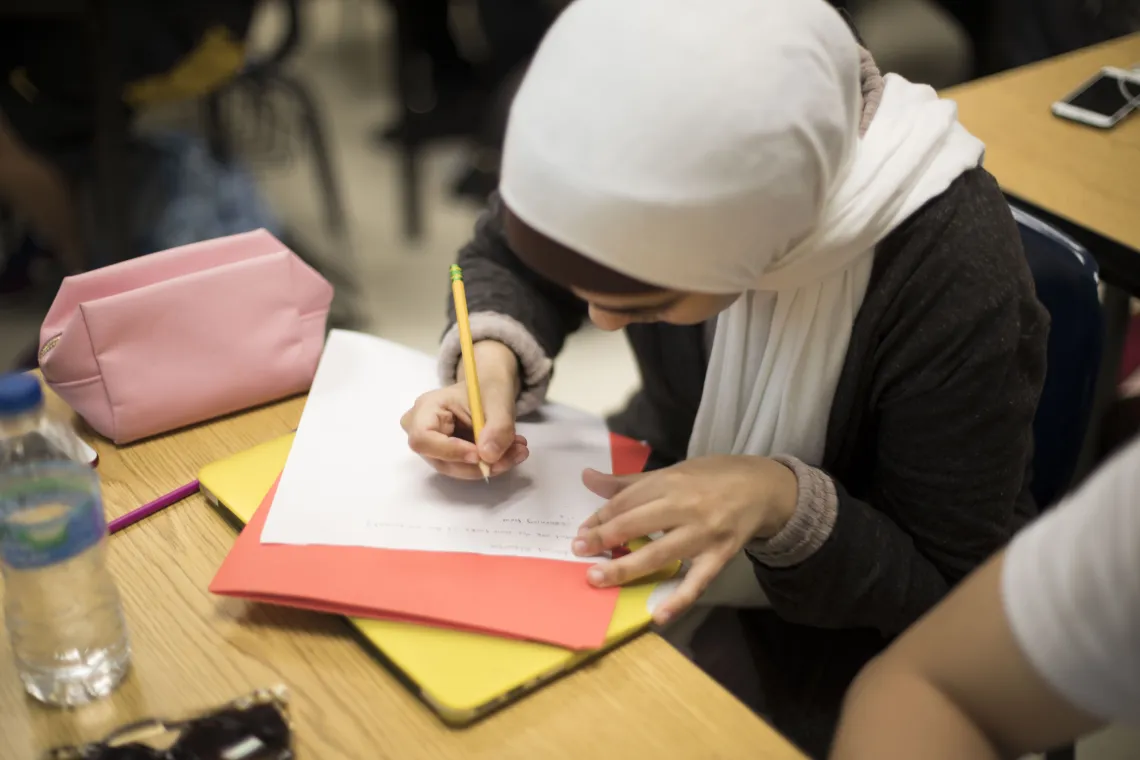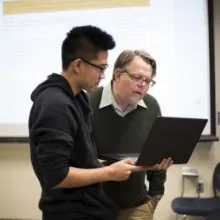UA Writing Program Awarded For Excellence

A student in a writing course taught by Jamey Rogers. Photo by Z Saenz, SBS Tech
Research shows that writing is a fundamental skill that helps ensure graduation. Clear and effective writing can help students excel in college and beyond, regardless of their major.
Acknowledging the importance of writing skills, the University of Arizona recently made investments in the UA Writing Program, which teaches foundational writing to almost every students who attends the UA. By focusing on writing outcomes, introducing smaller class sizes, and improving the working conditions of lecturers, the UA made a commitment to student success.
Results came quickly. The UA Writing Program, which is housed in the Department of English in the College of Social and Behavioral Sciences, received the 2017-2018 Writing Program Certificate of Excellence from the Conference on College Composition and Communication. According to Susan Miller-Cochran, director of the Writing Program, this is the most prestigious award a writing program can earn. The program was one of nine across the country acknowledged for excellence in writing instruction. A team of UA instructors will receive the award at the annual convention on March 16, 2018.
Miller-Cochran credits the award to the collective efforts of many, including the faculty in the Writing Program, the College of SBS, the Office for Student Success, and the Provost’s Office.
“The UA is proud of the Writing Program and the excellence it has provided to our students for many years – this recognition is highly deserved,” said Andrew Comrie, former provost and senior vice president for academic affairs.
A Focus on Outcomes
Instructors in the Writing Program teach about 6,000 students each semester. “This program touches every first-year student the day they step on campus,” said John Paul Jones III, dean of the College of Social and Behavioral Sciences.

“Recently we have started to shift to a curriculum that focuses on what students are learning rather than on what they are doing,” Miller-Cochran said. This focus on outcomes also gives instructors more flexibility when creating assignments.
Outcomes include critical thinking and composing, rhetorical analysis, understanding the audience and purpose of a text, assessing the credibility of sources, and revision and reflection.
“We prepare students for the types of writing that they will do later,” Miller-Cochran said. For example, instructors might ask students to consider questions such as, “What are some of the conventions for someone writing in the sciences versus writing in the humanities?”
Students also become aware of various genres, such as the difference between writing an email or an article for an academic journal.
One of the important goals of the first-year writing courses is to introduce students to the role of research inquiry in the writing process. Librarian liaisons have been critical partners in developing curriculum components that range from organizing a literature search, to understanding citation tools and guides, to avoiding plagiarism.
“I work with the library almost anytime I teach the 101 and 107 sections,” lecturer Kristin Little said. “They are tremendous.”
Becca Rogers, who graduated in December with a neuroscience major, was a transfer student when she took her UA writing course. “Rhetoric was the focus of the class, and this can be applied to absolutely anywhere in life. In the future I know that these writing skills will apply to grant writing, research, and hopefully publishing my own papers.”
Reducing Class Size
“Since 2015, reduced class size was one of our top three goals,” said Joel Smith, a career-track lecturer in the Writing Program. For faculty, “Going from teaching 100 students per semester to 76 is sizable. And for grad students, it means going from 50 to 38.”
The Writing Program faculty argued that students would be better served if classes had fewer than 20 students per class. Individualized feedback improves writing but takes time.
Aimee Mapes, assistant director of the Writing Program, adds that in order for students to refine their writing throughout their college and career trajectory, “they need to have careful readers of their writing early on.”
The decision to reduce the class size from 25 to 19 costs money, an investment the UA decided was worth it.
“Effective teaching and learning of writing requires plenty of feedback between student and instructor, so the investment to ensure smaller class sizes was aimed directly at quality and improving student success in writing,” said Comrie.
Supporting Faculty
When examining class size, Miller-Cochran was also concerned how the larger classes were impacting the working conditions of the instructors and graduate students teaching these courses.
“We know that the number one variable that affects learning is teaching,” Mapes said.
“Teachers’ working conditions are students’ learning conditions,” Miller-Cochran agreed.
In addition to lower class sizes, the faculty have also received a salary bump, full-year or multi-year contracts, and time for professional development.
“SBS is deeply committed to the success of all UA students. A strong foundation in academic writing plus the opportunity to acclimate to the university through interaction with other students and our teachers are key to ensuring students stay at the university. This goal cannot be achieved without well-supported teachers,” said Amy Kimme Hea, associate dean for academic affairs and student success in the College of Social and Behavioral Sciences. Kimme Hea was also the former director of the Writing Program.
The award committee noted these initiatives in their letter: “The committee applauds the effort within this program to establish meaningful, livable, stable non-tenure track positions with shared governance and opportunities for professional development.”
“For me, these developments, such as the smaller class size and the multi-year contracts, just reinforce my desire to be committed to this program,” Little said. “This is where I want to stay and have my career.”
Next Steps
The UA plans to continue innovating the Writing Program, adapting it to meet the needs of the students.
Miller-Cochran said the program will further develop its relationships with other parts of campus, connecting what students do in the foundational writing classes with what they will do later in their major.
This semester, the Writing Program has also created a pilot program to train select writing faculty to use Adobe Spark – a graphics, web page and video story platform – and integrate a Spark assignment in the first-year writing curriculum.
“The pilot program is part of the College of Social and Behavioral Science’s efforts to leverage UA’s status as an Adobe Creative Campus and to provide students with a skill set that is highly desired by employers,” said Kimme Hea.

